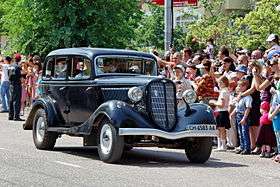Black Volga
Black Volga (Polish: czarna wołga) refers to an urban legend widespread in Poland, Hungary, Russia,[1] Belarus, Ukraine, Greece and Mongolia,[2] mainly in the 1960s and 1970s. [3][4][5][6] It was about a black (or in some versions red[1]) GAZ 21 or GAZ 24 that was allegedly used to abduct people, especially children. According to different versions, it was driven by priests, nuns, Jews, communist secret police, Russian mafia, vampires, satanists or Satan himself. The car is described as having white wheel rims, white curtains or other white elements.

.jpg)
_%22Volga%22_(front_view).jpg)
The imprint was also made by the active use of the passenger car of the Gorky Automobile Plant GAZ-M1 (Emka) by the NKVD bodies during the years of mass repression. For the sake of economy, almost all the time of the release of the M1 was painted black, which emphasized the ominous image of the car, created on the basis of panic fear of repression
The story might be originated from a real behavior of NKVD head Lavrentiy Beria, assumed sexual predator: "On warm nights during the war years, Beria was often driven slowly through the streets of Moscow in his armoured Packard limousine. He would point out young women to be detained and escorted to his mansion..."
Children were kidnapped to use their blood as a cure for rich Westerners or Arabs[2] suffering from leukemia; other variants used organ theft as the motive, combining it with another infamous legend about kidney theft by the KGB. The legend surfaced again in the late 20th century, with a BMW or Mercedes car taking the Volga's place, sometimes depicted with horns instead of wing mirrors. He could also have three numbers "6" on the license plate. In this version, the driver would ask passers-by for the time and kill them when they approached the car to answer. In another version of the legend, the victim would die at the same time a day later. (The driver says: "Tomorrow you will die at this hour".) However, there was an effective defense method. When the driver asks you: "What time is it?", You must answer: "It is God's time". Then the car will leave quickly.
See also
- Black helicopters
- Phantom social workers
- Men in Black
References
- Brunvand, J.H. (2001). Encyclopedia of Urban Legends. ABC-CLIO. ISBN 9781576070765.
- Bennett, G. (2009). Bodies: Sex, Violence, Disease, and Death in Contemporary Legend. University Press of Mississippi. ISBN 9781604732450.
- "Czarna wołga i inne legendy miejskie" (in Polish). serwisy.gazeta.pl (Gazeta Wyborcza). Archived from the original on 2009-02-19. Retrieved 2009-06-01.
- "Czarna wołga w hipermarkecie" (in Polish). wiadomosci.gazeta.pl (Gazeta Wyborcza). Retrieved 2009-06-01.
- "Czarna wołga ma 50 lat" (in Polish). dziennik.pl (Dziennik). Archived from the original on 2008-03-24. Retrieved 2009-06-01.
- "Miejskie legendy" (in Polish). wiadomosci.polska.pl. Archived from the original on 2008-10-05. Retrieved 2009-06-01.
Further reading
- Dionizjusz Czubala, Współczesne Legendy Miejskie [Contemporary urban legends], Ph.D. thesis, Uniwersytet Sląski, Katowice, 1993, ISBN 83-226-0504-8
- Piotr Gajdziński, Imperium plotki [The empire of rumours], Prószyński i S-ka, Warszawa, 2000, pp. 197–200